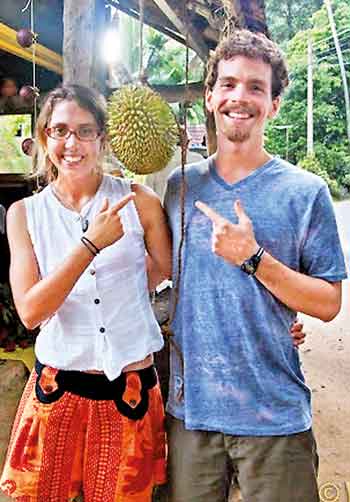Country-hopping on a Durian trail

Lindsay and partner Rob in Sri Lanka. Pic courtesy www.yearofthedurian.com
How do you start a durian tasting “flight”? Lindsay Gasik’s advice is simple: begin with a fruit that is mild and sweet. From there, work your way up to the more challenging flavours, the fruits whose flesh is pungent, alcoholic or even bitter, laced with the hints of chocolate or coffee.
A kind of durian sommelier, Lindsay decides what to serve depending on the variety she has access to, the quirks of the season and the smell of the fruit. You’d be surprised by how much in demand her skills are. This year she will lead six durian tours and is planning to continue expanding in 2018 with a tour in Borneo and another to the Philippines in 2019.
“Eating durian is definitely a focus of my tours,” she says. “But I also try to put a lot of emphasis on creating meaningful conversations and relationships between my tour guests and the durian farmers we meet. That’s what travel and really being alive is all about.” Her blog, about the year she spent travelling South East Asia in dedicated pursuit of durians, has over 1.5 million page views.
A self-dubbed freelance travel writer with a passion for horticulture, veganism, and of (course) durian, Lindsay wasn’t born a champion of this stinky fruit. In fact her first taste of it was underwhelming – coming in the form of a frozen ice cream bought from a small Chinese grocery near her house.
On her tongue, the ice cream was the flavour of vanilla dusted in chives. It wasn’t earth-shattering, but it nevertheless kicked off an obsession with what she would later describe, with hardly any exaggeration, as the “strange, ridiculous, wonderful stories about durian.” Lindsay was amazed to find reports of planes crashing because of durian smugglers, a quarrel over sharing a durian ending in a bloody murder, durians for sale at exorbitant prices that only royals could afford. She was hooked.
She has come to appreciate that even the most dedicated fans may find themselves surprised by what a durian has to offer. “Durian is so variant because it has over 200 aromatic volatiles – more than wine,” says Lindsay, explaining that it is quite a complex mouthful. Its environment seeps into the durian, flavouring the fruit. For instance, when the forest fires are burning in Indonesia, Lindsay says the durians take on a smoky taste. The fruits also vary in their fat and sugar content, as well as the ratio of saturated to non-saturated fat, all of which contributes to further variations in flavour.
Lindsay began her own journey when she decided to follow the durian trail – chasing the fruit as they ripened in an edible chain that crossed borders and linked landscapes. “Durians flower and fruit depend on the monsoonal rainy season, which moves in a circle around Southeast Asia,” Lindsay tells the Sunday Times in an email, adding,“If you want to, you can stay in durian season 365 days of the year just by moving countries.” This is what she did (and why her blog is called Year of the Durian).
It even brought her here, to Sri Lanka. On her second visit, she and her partner Rob lived in Ratnapura for a few months. Sadly, the durian brought to the market disappointed them. More often than not, it was of poor quality; riddled with disease and mould. “The best durians I had were from small roadside stalls where the durian was very fresh,” she recalls.“In general, durians in Sri Lanka are seedlings, not named varieties, so they differ a lot in quality.”
In a blog from that time she would note that the Horticultural Research Centre in Horana had bred a few varieties they deem superior to the local, which are available for purchase, but they haven’t really caught on. Enterprising farmers had established large-scale farms with grafted varieties, but the trees would take a few years to begin producing fruit. Lindsay hopes that she will return some day, and perhaps she will bring some durian devotees with her.
Her time on the trail left her with a deep appreciation of the generosity people in this part of the world. She says her passion for durian has had unexpected benefits: “I also loved how durian put me into situations and into conversations that I otherwise would not have had, and my life is richer and full of more people and friends because of it.”


